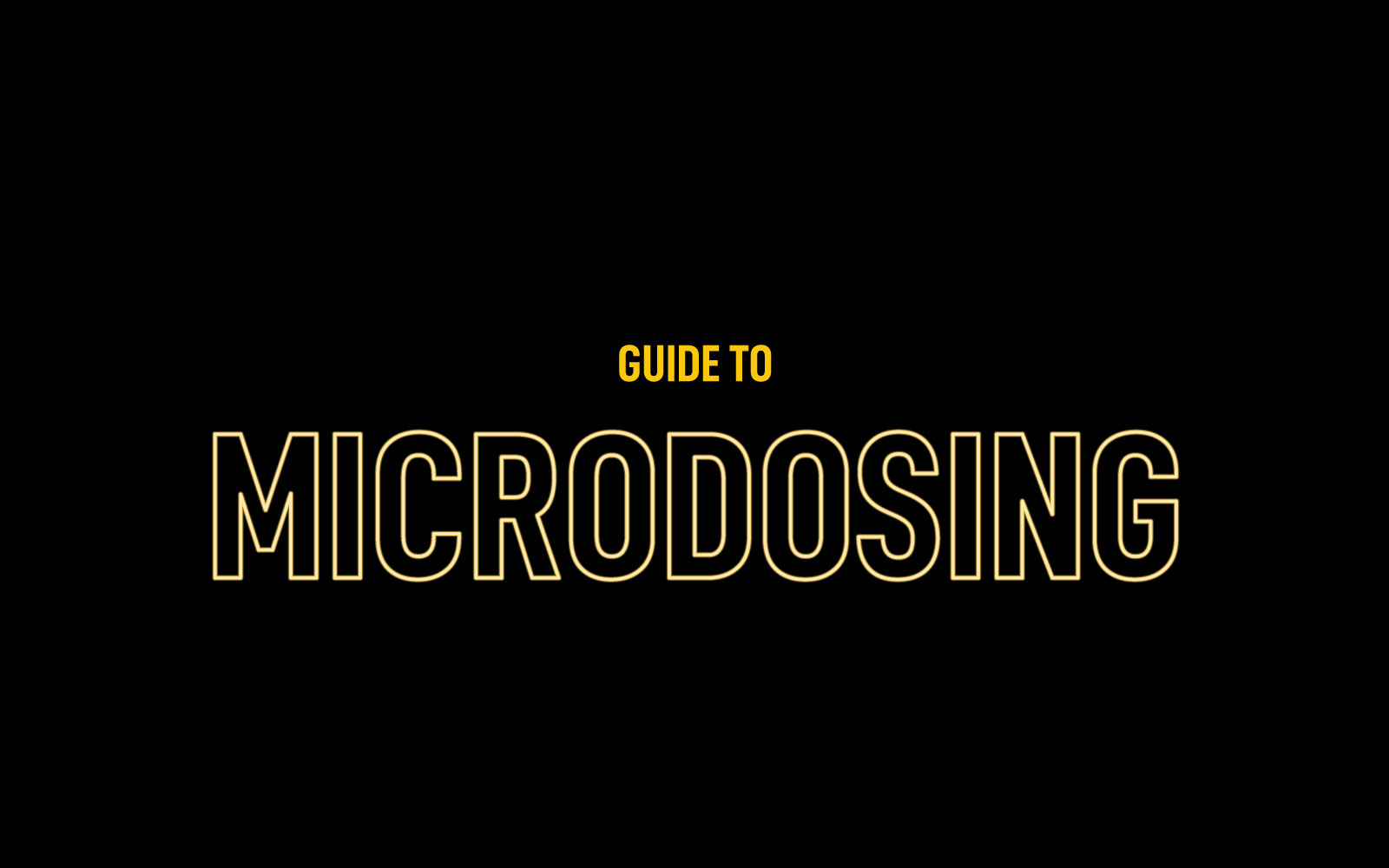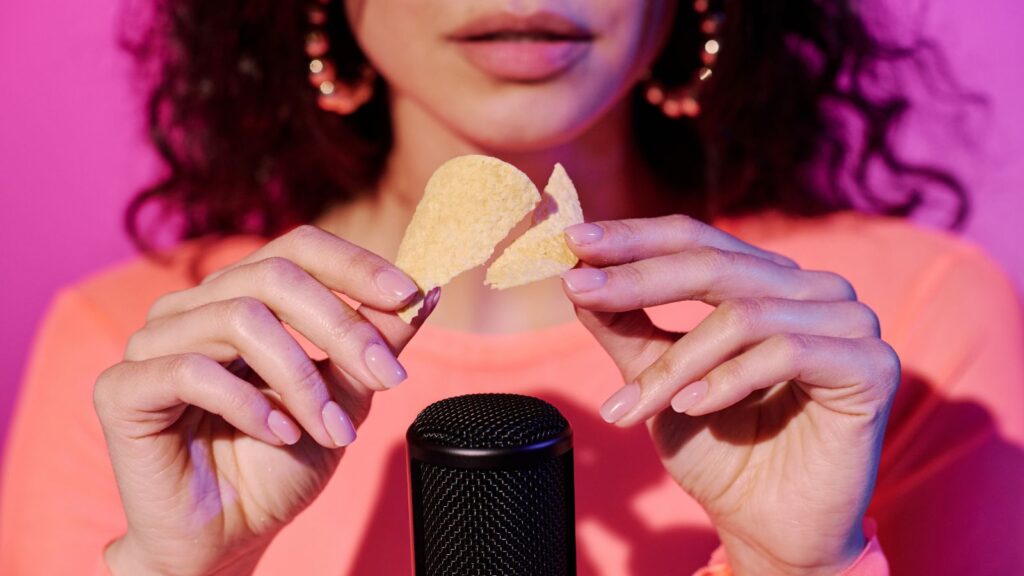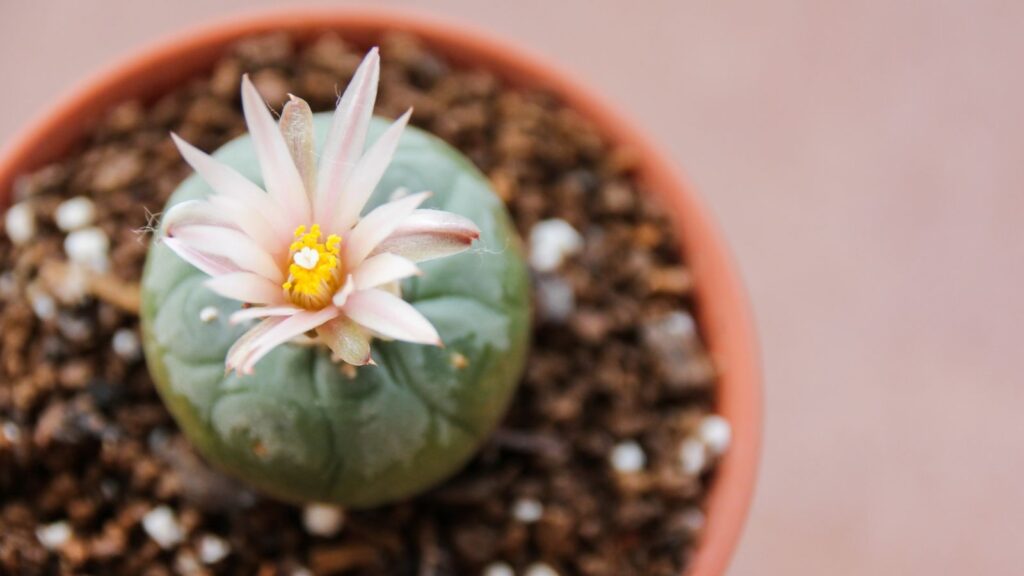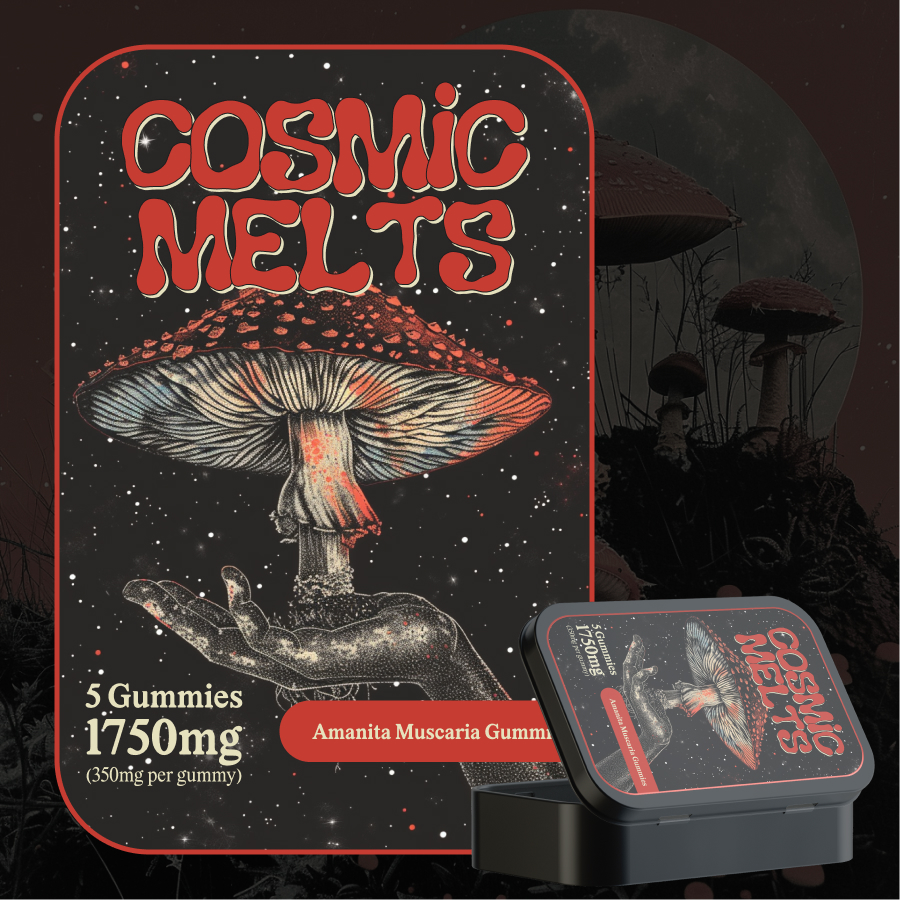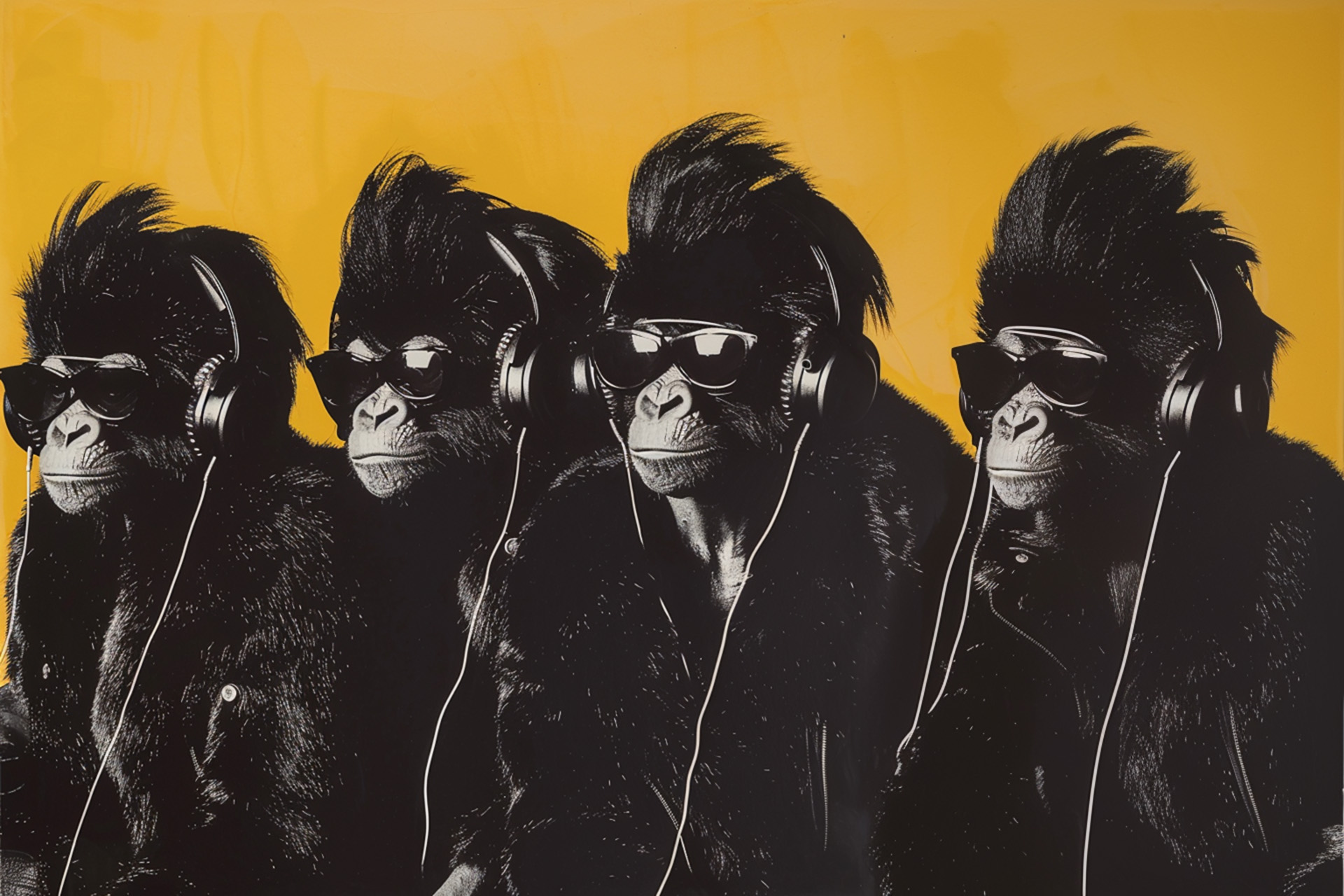In the growing environment of psychedelic clinical trials and destigmatization efforts, microdosing is a hot-button topic whose benefits and risks yearn for scientific consensus. Plenty of anecdotal evidence suggests microdosing can enhance mood, creativity, and well-being—among many other benefits. For some people, microdosing continues to provide tremendous relief from the stresses and isolation inherent in the COVID-19 pandemic era.
But despite the promising anecdotes, robust scientific evidence is urgently needed. Rigorous, controlled microdosing studies could pave the way to mainstream acceptance of the practice, further normalize psychedelic therapies in general, and potentially lead to FDA approval down the road. Fortunately, an increasing number of researchers are beginning to explore the risks and rewards of microdosing. In this article, we will overview what microdosing entails, how it’s done, common substances used, and some potential risks that go along with the practice.
What is Microdosing?
Microdosing refers to the practice of taking small amounts of psychedelics well below the threshold where significant alterations in consciousness occur. Microdosing has seen tremendous growth in recent years, in part due to accelerating media coverage and increasing interest by researchers around the country. Initially, microdosing was popularized in the mid-2010s within entrepreneurial and Silicon Valley tech circles, but the practice has since swept across the country.
Microdosing entered the psychedelic lexicon following the publication of James Fadiman’s The Psychedelic Explorer’s Guide in 2011. This book inspired low dose self-experimentation for innumerable individuals irrespective of profession, anyone from low-wage workers and students to musicians, doctors, and scientists. It’s important to note, however, that people have been microdosing long before James Fadiman, Steve Jobs, and others spoke highly of its benefits. According to Dr. Fadiman, indigenous peoples have consumed low doses of various psychedelics for centuries (having surely been familiar with every imaginable dose range). Even Albert Hofmann, the Swiss inventor of LSD, regularly took 10–20 microgram doses of LSD in the last decades of his life for its cognition-enhancing and antidepressant effects.
Macrodoses of psychedelics typically produce highly altered states of consciousness that, while therapeutically and spiritually profound, are not compatible with work or school activities. Microdoses, however, allow the user to seamlessly integrate their daily tasks with the sub-hallucinogenic benefits of psychedelics, namely a nootropic-like undercurrent of focus, energy, flow, and presence.
Microdoses are generally defined as 1/10 to 1/20 of a full recreational dose. For psilocybin, this comes out to be about 0.1–0.3 g of dried mushroom, and for LSD anywhere from 5–20 micrograms. These two classical psychedelics are the ones most commonly microdosed. But as we’ll explore later, many other substances are microdosed with great results.
Reasons for Microdosing
Microdosing science is mostly terra incognita, and so most of the benefits are derived from anecdotal reports. The vast amount of positive anecdotes, however, signal that microdosing may have similar long-term benefits as taking full recreational amounts. Indeed, many individuals find that the beneficial effects of microdosing extend into non-dosing days and potentially out into the long-term. This implies microdoses are capable of establishing more beneficial neural pathways that are in line with the values and goals of our ideal selves. Future well-designed clinical studies will shed light on the durability of these claims, as well as whether or not these effects fully take form after cumulative doses or after just a single dose.
Individuals may begin microdosing for a variety of reasons—anything from improving creativity and productivity in the workplace to improving mental health, general wellness, and interpersonal relationships. Let’s take a more in-depth look at some of the experiential realms where microdosing has been reported to help.
Enhancing Creativity and Productivity
The ability of microdosing to improve productivity caught the eye of Silicon Valley in the 2010s. Since then, the practice has swept through the start-up culture and general population. In the context of professional development, individuals may microdose to maintain motivation, and to focus longer and more intensely on work responsibilities. They may find themselves less susceptible to procrastination and more engaged in a flow state once they begin working. Many find an increased ability to generate novel solutions to problems, as their minds tend to operate in a more associational manner with less critical self-filtering.
In James Fadiman’s The Psychedelic Explorer’s Guide, a survey respondent named Charles describes the benefits of taking microdoses of LSD once every three days. In regard to the effects on his productivity and creativity, he says:
“I’ve found that I’ve had some brilliant outbursts (at least they seemed brilliant to me) with respect to both work product and personal creative projects. What seems to happen is that the “flow” state, described by Mihaly Csikszentmihalyi and noted frequently in the sports arena, is a lot easier to access and stay in. Also, it’s relatively easy to access and stay in the state that the consciousness explorer John Lilly once called your “professional satori.” [T]hat is, you are doing what you do professionally, you are doing it well, time passes quickly, and you are pleased with your output. If you have a serious work project, if a lot is due all at once and you feel under the gun, you will want to think twice about microdosing but it may just pay off.”
Generally speaking, people report microdosing boosts their creative and professional endeavors by:
- Reducing creative blocks
- Increasing access to flow states
- Aiding in the discovery of one’s purpose
- Helping to overcome procrastination
- Heightening mental clarity
- Improving problem-solving
- Enhancing divergent and “outside-the-box” thinking
- Optimizing athletic performance
Improving Mood and Well-Being
Against the backdrop of the FDA’s breakthrough therapy status for psilocybin, MDMA, and ketamine treatment, it makes sense that microdoses of these substances could offer substantial mental health benefits. According to anecdotal reports, many microdosers gravitate toward microdosing as a tool to improve mental health, particularly to relieve anxiety, depression, obsessive-compulsive disorder (OCD), post-traumatic stress disorder (PTSD), and ADD/ADHD. For many, it substitutes as a more effective and safer alternative to conventional pharmaceutical drugs, the vast majority of which carry more risks and adverse effects. In addition, in contrast to pharmaceutical drugs which merely provide symptom management, psychedelic therapy tackles the source of problems at their root, for lasting psychological relief.
A Reddit user reported his positive experience microdosing 0.1 g of psilocybin on the Stamets protocol. After two weeks on the protocol, he described significant reductions in anxiety, depression, lethargy, and intrusive thoughts. He claimed that,
“After 42 years I can only imagine how life would have gone had this treatment been available in my 20s when I first got counseling for my childhood trauma. It’s like I am suddenly no longer dragging around the anchor that has been weighing me down. I am going out more, exploring my interests. I have the freedom from existential dread to actually engage in life, trying everything I have been too overwhelmed to try for years. It’s awesome!”
Some commonly reported effects on mood and well-being include:
- Enhanced positive emotions/mood lift
- Increased energy, focus, and motivation
- Enhanced emotional self-awareness
- Increased self-acceptance
- Greater attunement to the needs of the body
- Diminished tendency to engage in destructive habits
- Reductions in anxiety and depression symptoms
- Improvements to post-traumatic stress disorder
- Decreased rigid thinking associated with obsessive-compulsive disorder
- Improvements in drug and alcohol dependence and cravings
- Decreased pain (chronic pain disorders, menstrual cramps, migraines)
Boosting Quality of Relationships
Microdosing may assist in dismantling negative habitual thought patterns and behaviors that interfere with healthy interpersonal relationships. Many people begin microdosing with the intention of specifically improving interpersonal relations, especially when using psychedelics in conjunction with psychotherapeutic work. Macrodoses of psychedelics have been demonstrated to restructure the personality, especially along the dimension of openness, so these effects may extend into microdoses as well.
A survey respondent named Madeline in The Psychedelic Explorer’s Guide describes her microdosing experiences with 10 to 20 microgram doses of LSD. On the topic of how microdosing has had an impact on her relationships, she states,
“Following conversations with relatives and friends, they would report feeling truly seen. Within only a few months of discovering subdoses, my skills as a listener and communicator had blossomed. Interestingly, a number of family members appointed me executor to their estates almost immediately after I began using subdoses.”
Generally, in the realm of relationships, anecdotal reports describe how microdosing produces:
- Increased openness
- Enhanced sociability and extroversion
- Increased empathy and compassion
- Greater sense of interpersonal connection
- Decreased social anxiety
How to Microdose
Set an Intention
First, being intentional with microdosing goes a long way toward a positive experience. It can help to set defined intentions before starting, reflecting on what changes you want to make with the regimen and what areas of your life you would like to improve. Later on, journaling how you are feeling each day throughout the microdosing regimen can aid in gauging its therapeutic potential, which may vary considerably from person to person.
Source Your Substance
Since the substances used for microdosing are currently controlled and unregulated, it can be difficult to know how trustworthy, safe, or pure your substance is. Sourcing generally involves establishing trustworthy connections within your local psychedelic community. Thankfully, with the destigmatization of psychedelics, a multitude of psychedelic societies have emerged around the country. These are ideal places to build connections and relationships. Others navigate to the dark web markets to source their psychedelics. While often successful, this carries inherent risks even with the use of anonymous software and cryptocurrencies.
Some people prefer to source in-house by growing their own mushrooms starting from mushroom spores. This process takes a matter of weeks and bypasses the inherent risks of gathering mushrooms in the wild. LSD is significantly harder to make (not to mention highly illegal). So outside sourcing is the only method available in this case.
Decide on a Dosing Schedule
When it comes to a microdose regimen, there are a variety of dosing schedules to choose from. The best advice is to experiment through trial and error to see which one works best for you. Some users microdose every other day. Others may microdose on a weekday schedule, from Monday to Friday, and then take a break on the weekends. Many find success in Fadiman’s protocol, which involves dosing one day and then taking a break for two days, and repeating this cycle.
Repeated dosing eventually leads to the development of tolerance. Accordingly, alternating days or taking a break for a few days can prevent this. Many people report the positive effects extend into the non-dosing days. No matter the dosing schedule used, it’s recommended to not exceed a dosing cycle length of 90 days, with a hiatus of about a month in between each cycle. It’s best to first try microdosing on a weekend, or a day when there aren’t many responsibilities, in order to calibrate the ideal dose for you. In some cases, the effects may be more pronounced than you originally thought.
Once a dosing schedule is chosen that fits around the responsibilities of a given week, it’s common for people to combine microdoses with other supplements. One protocol popularized by the mycologist Paul Stamets involves a cognition-enhancing combination of a psilocybin microdose, lion’s mane extract, and niacin (vitamin B3). For this stack, Stamets recommends a five-day-on, two-day-off schedule to prevent tolerance.
Common Substances to Microdose
DMT
Overview: DMT, or N,N-dimethyltryptamine, is a powerful, short-lasting serotonergic psychedelic. It is found throughout the plant and animal kingdoms. People have consumed it in the form of ayahuasca and psychedelic snuffs for centuries. A common dose range for microdosing DMT varies from 2–10 mg, depending on individual sensitivity.
Forms: Users either smoke or vaporized the freebase form of DMT. It can also be taken in the form of a plant-based brew with an MAOI.
Legality: While DMT-containing plants are generally unrestricted, extracted DMT is illegal in the United States and in the vast majority of countries around the world.
Effects: Within a matter of seconds after consuming a DMT microdose, people report enhanced visual acuity, mindfulness, focus, and creativity. It’s common to feel relief from symptoms of depression and anxiety, an effect which has been supported by animal studies. DMT microdoses can also enhance introspection and self-realization, both of which can catalyze significant personal transformation.
Ayahuasca
Overview: Ayahuasca is a psychedelic tea composed of several South American plants, namely Banisteriopsis caapi and Psychotria viridis (or chacruna). The former plant acts as an MAOI, allowing the dimethyltryptamine (DMT) in P. viridis to remain active in the digestive system, where it then absorbs into the bloodstream. In the brain, DMT closely mimics serotonin, binding to 5-HT2A receptors and producing a powerful, short-lasting trip. Microdosing ayahuasca involves drinking a tenth or twentieth of the normal brew amount.
Forms: Ayahuasca is consumed orally in the form of a tea.
Legality: DMT, the main psychoactive component of ayahuasca, is a Schedule I substance in the United States. Similar restrictions exist in numerous other countries within the EU and elsewhere. The raw ingredients are not controlled in the same manner, so some individuals purchase these online to make homemade ayahuasca.
Effects: The first noticeable effects begin within 30–40 minutes after ingestion. Users that take it in the morning generally report enhanced visual perception, creativity, sociability, and libido. Some users report lack of motivation for strenuous physical and mental tasks, which could make customary work activities difficult. When taken at night, it can lead to refreshing, rejuvenating sleep with vivid dreams.
Cannabis
Overview: Cannabis is a psychoactive plant in the Cannabaceae family that’s used for medicinal and recreational purposes. Cannabis contains over 500 compounds, but the most well-known and researched are THC (tetrahydrocannabinol) and CBD (cannabidiol). THC is the main psychoactive compound in the plant. It metabolizes into CBN within the body and binds to cannabinoid receptors in the brain. A typical dose used for microdosing cannabis can range anywhere from 2–10 mg of THC.
Forms: It is possible to smoke, vaporize, or take cannabis orally using edibles, capsules, tinctures, and drinkable liquids. In addition, THC-infused creams, oils, lotions, or butters for topical application are available.
Legality: Although illegal under federal law in the United States, the medical use of cannabis is legal in 33 states. Recreational use (for those over 21 years of age) is legal in 11 states. A further 16 states have decriminalized cannabis use. Internationally, Canada and Uruguay have legalized the purchase, sale, and use of cannabis.
Effects: The effects of microdosing cannabis consist of mood and emotion enhancement, increased creativity and focus, and reductions in anxiety and depression. Microdosing also appears to help a wide variety of physical ailments, including inflammation, pain, nausea, fibromyalgia, and PTSD-associated nightmares.
Iboga
Overview: Iboga is a perennial shrub that’s native to central West Africa. The roots and bark of the plant contain a psychoactive tryptamine called ibogaine. In the brain, ibogaine has a complex pharmacology, interacting primarily with sigma-2 receptors, but also opioid and serotonin receptors. Depending on the form, ibogaine is microdosed in doses ranging from 50 to 100 mg. When consuming the powdered iboga root bark, many people find success with starting doses around 1 g.
Forms: Ibogaine is consumed in pure form or ground up into a powder. When microdosed, it is usually consumed in either powdered total alkaloid (TA) form or in a powdered hydrochloride salt form, the latter of which is more potent.
Legality: Iboga, including the extracted ibogaine, seeds, and whole plant, is illegal in the United States. It is restricted internationally as well, including in Australia, Canada, and a number of European countries.
Effects: Ibogaine is most commonly microdosed (and macrodosed) to treat addiction and cravings. Ibogaine can also bring on heightened introspection, which can be helpful to address and heal traumas and mood disorders. Many users report stimulating effects, including increased energy levels and focus. In addition, many users report feeling more productive and creative.
Ketamine
Overview: Ketamine is a dissociative anesthetic that produces its psychedelic and cognitive effects by antagonizing the NMDA receptor. Clinical trials have established that ketamine is a potent, fast-acting antidepressant. Anecdotally, microdosing ketamine results in similar antidepressant effects, typically at doses ranging from 0.1–0.2 mg/kg.
Forms: Ketamine, in its hydrochloride salt form, is most commonly snorted. It can also be taken orally, which produces a less intense but longer-lasting trip. It’s occasionally injected, particularly in medical settings.
Legality: In the United States, ketamine is a Schedule III controlled substance. The S-enantiomer, esketamine, is available by prescription for treatment-resistant depression in the form of a nasal spray.
Effects: Microdosing ketamine will not produce profound dissociation or hallucinations. Instead, people report a noticeable mood enhancement and a greater ability to talk about challenging subject matter. Depressed people commonly feel an enduring lift from their depressive symptoms.
LSD
Overview: LSD-25 is a semisynthetic ergoline alkaloid derived from ergot, a fungus that grows on rye. Like other serotonergic psychedelics, it produces its effects by binding to and activating serotonin 5-HT2A receptors. When microdosing LSD, users typically consume 5–12 micrograms.
Forms: LSD can be found dosed on blotter paper, and in liquid form, tablets, gel tabs, and gummies. When microdosing, users generally dissolve the drug in a solvent such as alcohol, which allows for accurate volumetric doses.
Legality: LSD is a Schedule I controlled substance in the United States. Internationally, it is controlled in a similar manner. In Portugal, possessing small quantities (500 micrograms or less) does not constitute a criminal offense.
Effects: Most people microdose LSD to boost energy, focus, and creativity, as well as enhance productivity in the workplace. Others find it to be a potent mental health tool, helping to alleviate symptoms of anxiety, depression, and addiction. A 2020 study published in the Journal of Psychopharmacology found that low doses of LSD provide analgesic effects by decreasing subjective levels of perceived pain.
Psilocybin
Overview: Psilocybin is the primary psychoactive tryptamine alkaloid present in magic mushrooms. In the brain, it primarily binds to serotonin 5-HT2A receptors to produce its effects on mood and cognition. It is found with variable potency among several genera of mushrooms, including Psilocybe, Panaeolus, Inocybe, and Gymnopilus. Microdosing psilocybin involves taking the equivalent of roughly 0.10 to 0.25 grams of dried mushroom powder, typically Psilocybe cubensis.
Forms: Psilocybin microdoses can be consumed by eating chocolate magic truffles, brewing a tea, or ingesting the dried mushroom (either eaten directly or taken as a capsule when made into a powder). Magic truffles are not actually the mushrooms, but the mushroom’s “sclerotium,” which is less potent than the fruiting body but still contains active psilocybin and psilocin.
Legality: Psilocybin is banned in most countries, except for Jamaica, Samoa, and the Netherlands. Buying the spores “for microscopy purposes” is generally legal, which is the first step that users take to begin cultivating their own private supply.
Effects: Anecdotally, users begin to feel a noticeable mood lift and an increase in energy and focus within an hour or two after consumption. Many individuals report feeling more connected to their emotions and more empathetic towards others. Noticeable reductions in anxiety and depression are also commonly noted, often with superior efficacy to that of conventional antidepressants. In terms of cognitive effects, a 2018 study by Prochazkova and colleagues investigated the benefits of microdoses (0.33 g) of psilocybin truffles in 36 participants. Using objective measures, the researchers found that both convergent (single-solution problem-solving) and divergent thinking (many possible solutions to a problem) were enhanced after a microdose, while fluid intelligence was unaffected.
Worst Case Scenario
Dosing Errors
As opposed to pharmaceuticals, whose dosages are highly standardized and exact, microdosing in its current state is an inexact science that is prone to dosing errors. Dosage mixups or imprecision in dosing can frequently lead to experiences that are in the minidose or even macrodose territory. These accidental overdoses can be distracting or even problematic in the context of most day-to-day responsibilities.
More complications in dosing arise from variations in potency among batches of LSD or the many varieties of psilocybin-containing mushrooms. Drug interactions may also confound the microdose regimen, and must therefore be taken into account. For instance, SSRIs are known to reduce the effects of psychedelics, while MAOIs generally potentiate the effects. It’s important to always start with the smallest possible dose (perhaps 5–6 micrograms of LSD or <0.1 g of dried psilocybin mushrooms) to gauge your sensitivity. From there, doses can be titrated up until a sweet spot is reached that is optimal for your intended uses.
Potential Side Effects and Contraindications
Microdosing is a new trend, and as such, clinical studies have not detailed the long-term effects and safety. However, many of the precautions for full recreational doses also apply to microdoses. While a full-fledged bad trip is virtually unheard of when microdosed psychedelics are consumed without other substances, the microdosing experience is still contingent on set and setting. Psychedelics, even at low doses, have a tendency to amplify any underlying emotional states. It’s recommended to not start a microdose regimen during a period of major upheaval or extreme stress.
While microdosing may provide relief for anxiety, for some individuals it can make anxiety worse or enhance paranoid tendencies. In some cases, this can be remedied by reducing the dose or stopping the regimen altogether. Microdosing LSD, especially at night, can lead to insomnia because of its longer duration of action. The vasoconstriction produced by LSD can also lead to headaches, muscle cramps, and increased blood pressure. For psilocybin, gastrointestinal distress is a commonly reported side effect, which can be prevented by dosing in powdered capsule form alongside ginger. In general, those with a history of psychosis, seizures, and heart ailments should avoid microdosing. LSD can reduce the seizure threshold, particularly in combination with lithium, stimulants, antidepressants, anesthetics, and antiasthmatics.
Legal Status
We are in the midst of a psychedelic renaissance, where the legal landscape for psychedelics is continually becoming less controlled. But currently, the biggest risk when it comes to microdosing is the fact that it tends to be illegal. As of this writing, the exceptions are due to the recent medicalization of marijuana and ketamine, which offer a safe and legal framework for their medical use without potential repercussions.
A growing body of evidence supports the safety and therapeutic potential of microdosing. And yet, the most popular microdosed substances—LSD and psilocybin—still maintain Schedule I status. This classification is reserved for drugs with high potential for abuse and no medical utility. As a consequence, users who have illegally sourced their substances can face heavy fines and incarceration. However, a collective movement toward less severe legal repercussions for using these substances is underway. In the United States, Denver, Colorado was the first city to decriminalize psilocybin, followed more recently by Santa Cruz and Oakland, California. Many other cities are attempting to follow suit as knowledge of the medical utility of psilocybin continues to gain acceptance.
Microdosing Education
Before beginning a microdosing regimen, it is helpful to get as informed as possible in order to craft an intentional, structured microdose schedule and minimize any potential risks. Thankfully, a plethora of online resources are available for guidance.
Events and Communities
- In May of 2020, Meet Delic presented a live discussion on microdosing with industry experts and psychedelic thought leaders. The playback for the virtual event can be found here.
- Reddit’s growing community of microdosers has over 120,000 users and contains plenty of information to learn more about microdosing. In addition to a comprehensive FAQ, you can discuss your experiences and questions with the microdosing community.
- The Beckley Foundation is a UK-based think tank that is spearheading placebo-controlled microdosing studies. Recently, in collaboration with Imperial College London, the Beckley Foundation has conducted the first self-blinding microdose study. This global naturalistic observation study allows self-experimenting volunteers to add placebo control to their microdosing regimen. This addition helps to delineate the true pharmacological effects of microdoses from psychological expectations. Currently, the first phase of the study is closed, but the publication of the results is expected later this year.
Recommended Books on Microdosing
- The Psychedelic Explorer’s Guide: Safe, Therapeutic, and Sacred Journeys by James Fadiman (2011).
- A Really Good Day: How Microdosing Made a Mega Difference in My Mood, My Marriage, and My Life by Ayelet Waldman (2017).
- Microdosing Psychedelics: A Practical Guide to Upgrade Your Life by Paul Austin (2018).
Disclaimer: The substances discussed in this guide are potentially categorized as an illegal drug(s). Reality Sandwich is not encouraging the use of these drugs where it is prohibited. However, we believe that providing information is imperative for the safety of those who choose to explore this substance. This guide is intended to give educational content and should in no way be viewed as medical recommendations.
